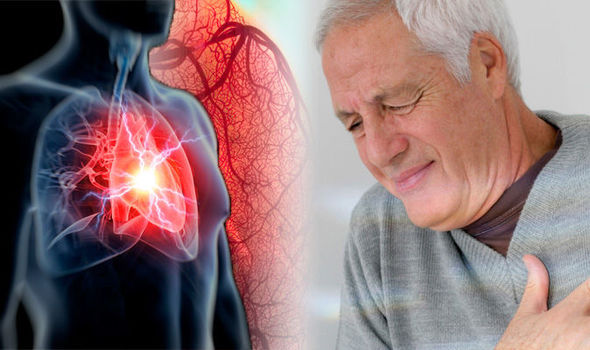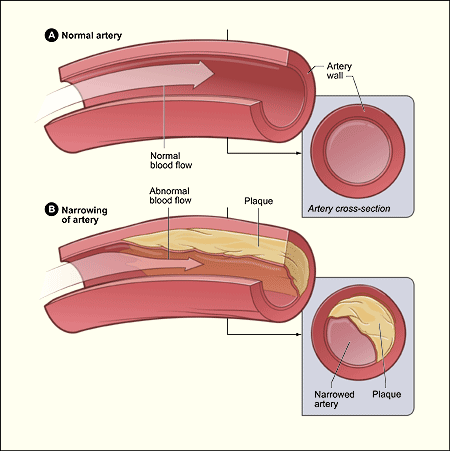SHARES

Atherosclerosis starts with the hardening and narrowing of arteries, which may then progress on to blocked blood flow in the artery, leading to serious conditions such as heart attacks, strokes etc.
Arteries are the blood vessels that transport oxygenated blood from the heart. A thin layer of cells, the endothelium, lines the walls of arteries. Damage to endothelium can occur due to high cholesterol, high blood pressure, inflammation, obesity, diabetes or smoking.
When damage to the endothelium occurs, plaque can begin to build up along the wall of the artery. The build up of plaque gets bigger as the atherosclerosis worsens. A plaque consists of mainly fat, cholesterol and calcium.
Eventually, the plaque may block the blood flow entirely, leading to conditions like heart attacks or strokes. Hence, slowing down plaque progression, or even reversing atherosclerosis, is crucial to prevent cardiovascular diseases.

Normal artery vs artery with plaque buildup (Image courtesy: UCSF)
Shrinking the Plaque with Extreme Dietary Habits
In the seventies, Dr Ornish conducted a study to investigate the effect of intensive lifestyle changes on the reversal of coronary heart diseases. Doctors prescribed drastic measures to the treatment group. The measures. include a strict diet, aerobic exercises, smoking cessation and stress management. Meanwhile, those in control group made only moderate changes in their lifestyle. Then, the researchers evaluated the subjects at both the 1-year and 5-year mark.
After one year, the reduction in low-density lipoprotein (the bad cholesterol, LDL) is 37.2 % in the treatment group. In comparison, the control group reported 6 % reduction. Although the treatment group reported 2.1 % reduction in artery blockage, the control group experienced 3.4 % increment instead.
At the 5-year mark, the rankings of the subjects were according to adherence to strict lifestyle: Highest, Medium and Least adherence. Subjects with highest adherence level had 6.81 % reduction in artery blockage, followed by 3.02 % for medium adherence, and 0.37 % with the least adherence.
The study successfully proved that strict lifestyle reverses atherosclerosis, leading to the introduction of the Ornish Diet. The diet consists of low-fat, lacto-ovo-vegetarian diet including soy products, egg whites and minimal non-fat dairy. The recommendation for optimal result is daily moderate exercises lasting 30 minutes. However, the Ornish diet may cause nutritional deficiencies if adopted without careful planning.
Lowering Bad Cholesterol with Statins
Doctors prescribe statins to reduce high cholesterol. A meta-analysis demonstrated that prolonged use of high dose statin in patients with cholesterol level maintained below 5.6 mmol/L is able to shrink atherosclerotic plaques.
Besides that, statins stabilise atherosclerotic plaque by strengthening it with fibre and calcium deposits. The plaque then becomes less prone to rupturing, which reduces the risk of heart attack or stroke due to enlarging plaque ruptures. In fact, doctors use statins in prevention of cardiovascular diseases for patients with specific risk factors.
Wonder Drug to Reverse Atherosclerosis under Study
In some cases, invasive medical procedures are required to treat severe atherosclerosis. Procedures like percutaneous coronary intervention (PCI) and coronary artery bypass grafting (CABG) may carry risk of complications, such as bleeding or infections at access site. Hence, these procedures are done only when absolutely necessary.
The good news is – a preliminary research for non-invasive therapy to stop and reverse atherosclerosis is underway. An intravenous injection to target the vessel wall with nanofibers to dissolve cholesterol is being tested on mice. So far, biweekly injections administered for eight weeks in atherosclerotic mice demonstrated favourable results with reduced plaque areas. However, more study is needed before it can be tested on humans.
Conclusion
Atherosclerosis may lead to heart attack or stroke when blocked arteries can no longer transport oxygenated blood. Although strict lifestyle and statins seem to be able to reverse atherosclerosis to a certain extent, more studies are required to understand the disease reversal. If you or your loved ones suffer from high cholesterol or symptoms of heart attack or stroke, consult a doctor immediately.
Further reads:
Find a Cardiologist or GP/Family Doctor in Malaysia, on GetDoc
Find a Cardiologist or GP/Family Doctor in Singapore, on GetDoc
by Joanne Lee
Multipotentialite. Loves creating and seeing ideas come alive. View all articles by Joanne Lee.





